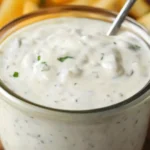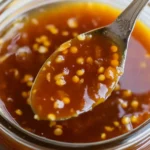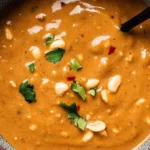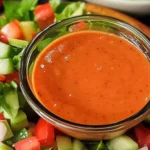Balsamic glaze pairs beautifully with grilled vegetables like zucchini, bell peppers, and asparagus, enhancing their natural sweetness and acidity. It also elevates a classic Caprese salad, adding a flavorful pop to mozzarella, tomatoes, and basil.
For roasted meats, glazing chicken or pork tenderloin creates a savory, caramelized finish. It complements sharp cheeses on a cheese plate and adds a sophisticated twist to fruit desserts like strawberries or peaches.
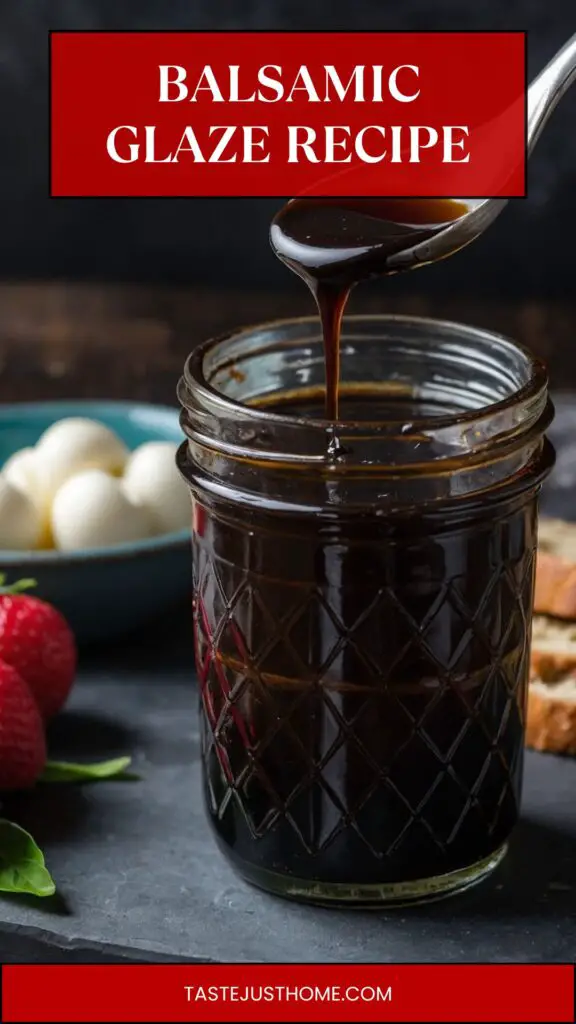
There’s something extraordinary about balsamic glaze. This glossy, dark liquid transforms your cooking, turning even the simplest dishes into culinary masterpieces.
As a registered dietitian and food enthusiast, I’ve experimented with countless recipes, and balsamic glaze ranks among my favorites. Black and rich, it’s a delightful blend of sweetness and acidity.
Whether you’re drizzling it on roasted veggies or pairing it with seasonal fruit, balsamic glaze adds a gourmet touch. Today, we will dive into the “how-to” of making your own balsamic glaze at home. Let’s unlock the secret to this delicious kitchen staple!
What is Balsamic Glaze?
Balsamic glaze is a reduced form of balsamic vinegar, thickened and sweetened to create a syrup-like condiment. Traditional balsamic vinegar is made from grape must, aged for a long time, resulting in a complex flavor.
Balsamic glaze captures that essence, offering a sweet-tart flavor that deepens as it reduces. Traditionally from Modena, Italy, this glaze has evolved into a beloved addition to many dishes worldwide.
You will also like the following Sauce & Condiment recipes!
Why This Recipe Works
Creating balsamic glaze at home is not just easy; it’s also satisfying. By slowly reducing balsamic vinegar with sugar, the result is a glossy, flavorful syrup that enhances every dish it touches. The glaze clings to ingredients, ensuring each bite bursts with flavor.
Plus, making it at home means you have complete control over the sweetness and thickness.
What You’ll Need to Make Balsamic Glaze
To make this delightful condiment, gather the following ingredients:
½ cup dark brown sugar
1 tablespoon freshly ground black pepper
2 cups aged balsamic vinegar
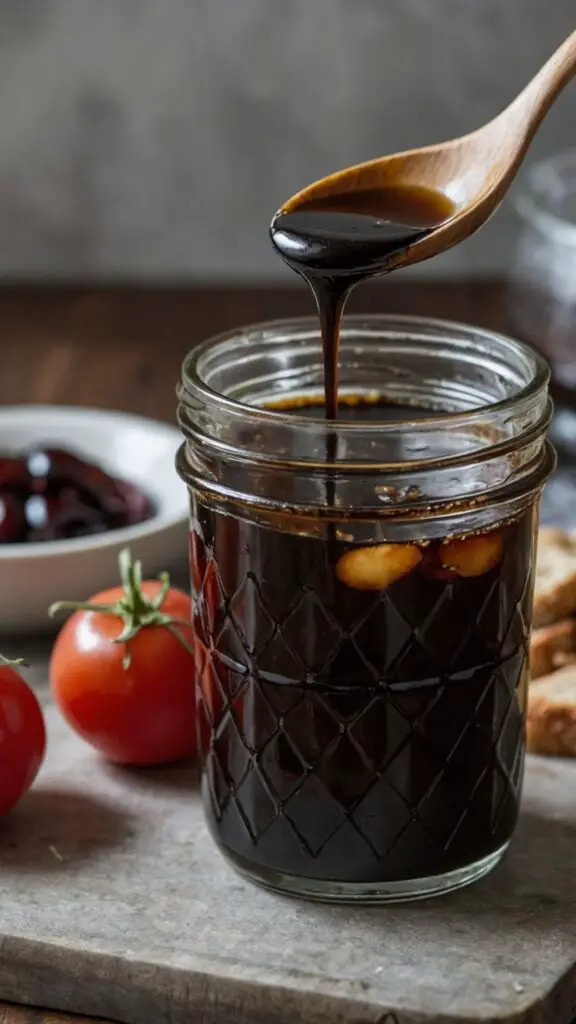
How to Make Balsamic Glaze
Making balsamic glaze is straightforward. You will simmer balsamic vinegar and sugar until it thickens into a syrup. The key here is patience. Let’s break it down step by step.
Step 1: Combine the Ingredients
Start by pouring the balsamic vinegar into a medium saucepan. Add the brown sugar and black pepper. Stir this mixture gently until the sugar is mostly dissolved, creating a homogenous liquid.
Step 2: Heat the Mixture
Place the saucepan over medium heat. Allow the mixture to come to a gentle boil while stirring occasionally. This initial step is crucial, as the heat activates the flavors and begins the reduction process.
Step 3: Reduce the Heat
Once boiling, reduce the heat to low. The goal is to keep a light simmer. You want to avoid a rolling boil, as it can lead to uneven reduction or burning.
Step 4: Stir Occasionally
Stir the mixture every few minutes. This keeps the sugars from settling at the bottom and burning. After about 15 to 20 minutes, you’ll notice the consistency begin to thicken.
Step 5: Check the Consistency
After about 20 minutes, use a spoon to test the glaze. It should coat the back of the spoon and have a syrupy texture. If it’s still too thin, continue cooking for an additional 5 to 10 minutes.
Step 6: Cool and Store
Once you reach your desired thickness, remove the saucepan from the heat. Allow the glaze to cool for a few minutes. It will thicken further as it cools. Once cooled, transfer it to an airtight container for storage.
Tips for the Perfect Balsamic Glaze
– Use Quality Vinegar: Higher-quality balsamic vinegar leads to better glaze. Look for aged varieties for deep flavors.
– Sugar Alternatives: Consider using honey or agave nectar if you’re avoiding brown sugar. Adjust quantities as needed.
– Avoid Overheating: Keep an eye on the heat, as too high can lead to caramelization rather than a syrup.
– Infuse Flavors: Consider adding garlic, rosemary, or thyme during cooking for an infused glaze. Just strain them out before cooling the mixture.
– Experiment with Ratios: Don’t hesitate to adjust sugar levels to match your personal preference. Some like it sweeter, while others prefer a more straightforward tang.
How to Store Leftovers
Balsamic glaze can be stored in an airtight container in the refrigerator for up to two weeks. Just make sure to let it cool completely before sealing.
If it thickens too much in the fridge, you can gently reheat it with a splash of water to return it to a pourable consistency.
Nutrition Information
Balsamic Glaze Recipe Nutrition Facts
How Would I Recommend Serving Balsamic Glaze?
1. With Grilled Chicken: A drizzle of balsamic glaze over grilled chicken can elevate your meal quite a bit. It adds depth, making the dish more exciting while keeping the chicken juicy.
2. On Roasted Brussel Sprouts: Imagine roasted Brussels sprouts, golden and crispy, then topped with balsamic glaze. It’s a mouthwatering side that can steal the spotlight.
3. With Artisan Bread: Use balsamic glaze as a dipping sauce for fresh crusty bread. Add olive oil, and you’ve got a simple yet gourmet start to any meal.
4. As a Salad Dressing: Use balsamic glaze sparingly over salads as a dressing. It not only adds flavor but also acts as a beautiful garnish.
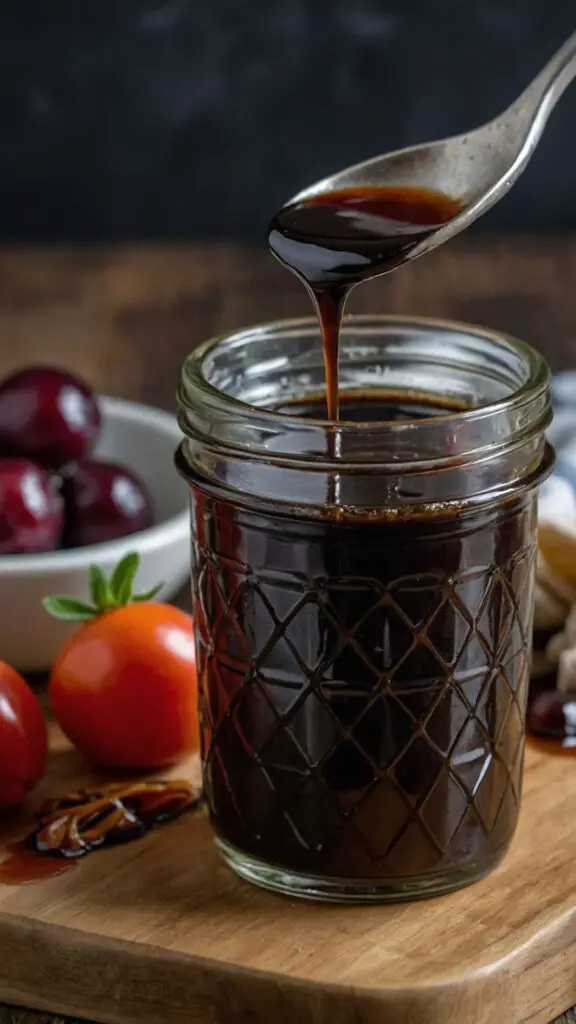
What Alternatives Can You Use for the Ingredients?
– White Sugar: If dark brown sugar is unavailable, you can use regular sugar. Keep in mind that it may alter the flavor slightly, but it will still work well.
– Red Wine Vinegar: In a pinch for balsamic vinegar, try red wine vinegar. The taste will be different but can still provide acidity and richness.
– Maple Syrup: Substitute brown sugar with maple syrup for a unique twist. Adjust the quantity, as syrup is generally sweeter.
– Apple Cider Vinegar: Another alternative for balsamic vinegar is apple cider vinegar. It has a different flavor profile but can add tanginess to your dish.
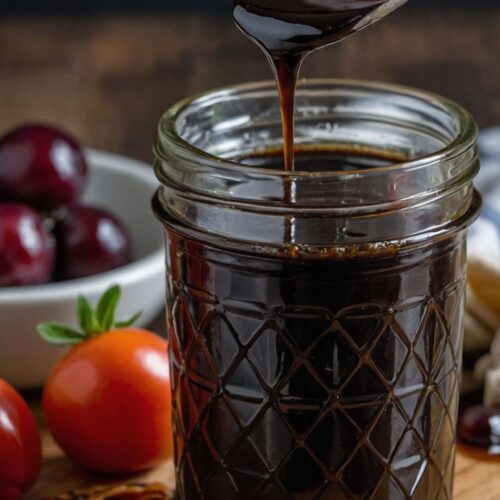
Balsamic Glaze Recipe
Equipment
- Medium saucepan
Ingredients
- ½ cup dark brown sugar
- 1 tablespoon freshly ground black pepper
- 2 cups aged balsamic vinegar
Instructions
Step 1: Combine the Ingredients
- Start by pouring the balsamic vinegar into a medium saucepan. Add the brown sugar and black pepper. Stir this mixture gently until the sugar is mostly dissolved, creating a homogenous liquid.
Step 2: Heat the Mixture
- Place the saucepan over medium heat. Allow the mixture to come to a gentle boil while stirring occasionally. This initial step is crucial, as the heat activates the flavors and begins the reduction process.
Step 3: Reduce the Heat
- Once boiling, reduce the heat to low. The goal is to keep a light simmer. You want to avoid a rolling boil, as it can lead to uneven reduction or burning.
Step 4: Stir Occasionally
- Stir the mixture every few minutes. This keeps the sugars from settling at the bottom and burning. After about 15 to 20 minutes, you’ll notice the consistency begin to thicken.
Step 5: Check the Consistency
- After about 20 minutes, use a spoon to test the glaze. It should coat the back of the spoon and have a syrupy texture. If it’s still too thin, continue cooking for an additional 5 to 10 minutes.
Step 6: Cool and Store
- Once you reach your desired thickness, remove the saucepan from the heat. Allow the glaze to cool for a few minutes. It will thicken further as it cools. Once cooled, transfer it to an airtight container for storage.
Notes
- Use Quality Vinegar: Higher-quality balsamic vinegar leads to better glaze. Look for aged varieties for deep flavors.
- Sugar Alternatives: Consider using honey or agave nectar if you’re avoiding brown sugar. Adjust quantities as needed.
- Avoid Overheating: Keep an eye on the heat, as too high can lead to caramelization rather than a syrup.
- Infuse Flavors: Consider adding garlic, rosemary, or thyme during cooking for an infused glaze. Just strain them out before cooling the mixture.
- Experiment with Ratios: Don’t hesitate to adjust sugar levels to match your personal preference. Some like it sweeter, while others prefer a more straightforward tang.
Nutrition
Frequently Asked Questions
1. Can I make balsamic glaze in larger batches?
Absolutely! Just adjust the quantities of vinegar and sugar proportionately. Ensure you simmer it until it reaches the desired consistency.
2. Can I freeze balsamic glaze?
Yes, balsamic glaze can be frozen. Pour it into ice cube trays for easy portions. Just thaw in the refrigerator when needed.
3. Is balsamic glaze good for people on a low-carb diet?
While balking at a sweet alternative, moderation is essential. A small drizzle can be worked into a low-carb regimen.
4. How long should I cook the glaze?
The cooking time can vary, but generally, aim for 20-30 minutes. Watch for your desired thickness.
5. Does balsamic glaze expire?
Generally, the glaze lasts several weeks in the fridge. However, its flavor might diminish over time.
6. What dishes don’t pair well with balsamic glaze?
Creamy, buttery dishes may clash with the acidity of balsamic glaze. Avoid pairing it with delicate seafood dishes, as it may overpower their subtle flavors.
Conclusion
Balsamic glaze is more than just a condiment; it’s a culinary enhancer that can transform your meals from simple to extraordinary.
With its rich, sweet-tart flavor, it complements a wide array of dishes. Making your own glaze is not only satisfying but an enjoyable process that results in a fresh product free from preservatives.
I hope this guide inspires you to make your balsamic glaze at home. It’s perfect for summer gatherings or cozy family dinners alike.
Whether stirred into salads, drizzled on meat, or enjoyed with fresh bread, the only limit is your imagination. Embrace this wonderful addition to your kitchen and enjoy the remarkable flavors it brings to your table!
You’ll also like these latest recipes!
- Best Instant Pot Chicken Wings From Fresh Or Frozen Recipe
- Best Red Wine Pot Roast
- Homemade Corned Beef Brine
Hi! I'm Mary Lee. I love helping people eat yummy and healthy food. I live in Oregon. Cooking is my happy place. Let's make tasty dishes together!

